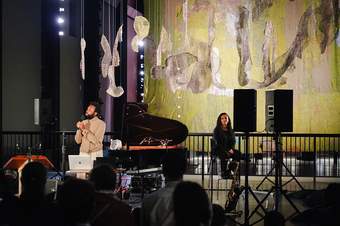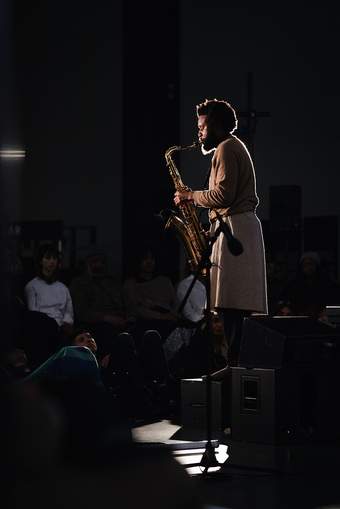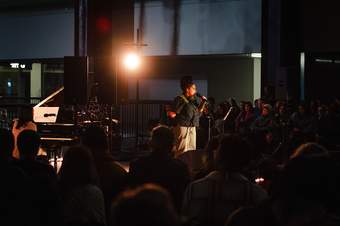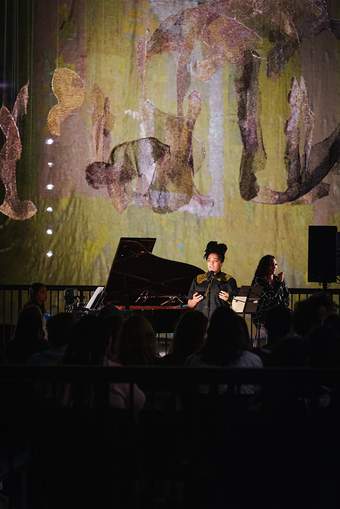Overarching the Turbine Hall is a bridge between the old – Tate Modern’s pre-redevelopment Natalie Bell Building, formerly the Boiler House – and the new – the 2016-minted Switch House extension, later renamed the Blavatnik Building. For two nights in March, this overpass hosted two distinct performances under the umbrella of ‘Voice and Breath’; the first by JJJJJerome Ellis and the second by Olivia Douglass. The context of the bridge was appropriate for two performances that occupied the in-between space of performance, poetry and music.
The ‘Voice and Breath’ programme builds on El Anatsui’s Hyundai Commission, Behind the Red Moon 2024. An installation in three acts, Anatsui’s theatrical framing gives shape to his ongoing interest in the cultural legacy of enslavement. A constellation of symbols – the moon, a wave, the earth, a sail, a wall – made from metal bottle caps and fragments refer to consumerism and industrial globalisation: the inextricability of ubiquitous objects such as the alcohol bottle cap from the legacy of modes of production established during the slave trade; a framing of our passive complicity with the reverberations of historical violences. The installation foregrounds the significance of encounter, in all senses of the word. The hanging constructions undulate in the manner of textiles, weaving together resonances, oral history and storytelling. In this way, the thematic links between the commission and the subsequent performances can be conceived of as threads.
On Thursday 7 March, JJJJJerome Ellis presented Trade Winds – the Virginia-based artist’s first live performance in London, composed of two parts. The first part, A Response, In Admiration, to El Anatsui’s ‘Behind the Red Moon’ 2024, constitutes music written after spending time with Anatsui’s Hyundai Commission. The second combines elements from Ellis’s The Clearing and Aster of Ceremonies, both ongoing bodies of work begun in 2021 and 2023 respectively. Across themes of ‘unknowing, improvisation, inheritance, opacity, prayer, gap, contradiction, aporia, eternity, unpredictability, interruption, and silence’,1 Ellis’s multidisciplinary practice primarily culminates in improvised sonic landscapes, which the artist refers to as ‘clearings’. The term evokes the idea of clearing one’s throat, an undercurrent made more significant by the fact of Ellis being a person who stammers. In the clearings, Ellis invites us to witness to the ‘dysfluency’ of a stammer. Spaces are created between letters, words and phrases; operating in a time outside of time, these expansions challenge typical conversational and musical tempo, and open up the opportunity to play with the notions of resistance and disobedience.

JJJJJerome Ellis (left) and Rachel Jones (right), performance at Tate Modern, 7 March 2024.
Photo © Tate (Jordan Anderson) 2024
I offer a descriptive outline of the space, just as Ellis started with a visual description of himself and his surroundings. The audience is seated in a semi-circle of five blocks of chairs, with cushions on the floor directly in front of the main ‘stage’. The curation of the space is an invitation to intimacy; the meditative atmosphere augmented by four warm spotlights, which shine upon and enter into shimmering interplay with Anatsui’s monumental installation. The artist begins his performance centre stage. Beside him sits Hildegard the Hippo, a plush toy from home, gifted to Ellis by his younger brother Calvin; a symbol of the love we carry even when far away. Love, and thanks, across space and time is revealed as central to Ellis’s performance and ethos. The first ‘thank you’ is delivered to BSL Interpreter, Rachel, who sits on a high stool to the rear stage-right. Next, I skip to the third ‘thank you’ (time is not linear), which was offered as a ‘thank you note to El Anatsui and his work’.
Ellis’s activation of Anatsui’s ‘symphonic sculptures’2 constituted music that paid tribute to the musical structures of diverse cultures, complementing and contrasting various styles and combining them with physical movement. Ellis invited the audience to listen as they wished: to come and/or go, and to liberate themselves from quiet, in a move away from the required hush of classical concert halls and their staid listening experience that ignores the interaction of melodies with the body’s rhythms. Just as our experience builds to make us the people we are today, Ellis constructs his melodies over time, stacking repeated and recurring motifs. The saxophone translation of his stammer injects a musical punctuation that contributes effectively to his defiance of Western musical construction, so based as it is in metrical, steady rhythms. Ellis’s tongued syncopations are reminiscent of a heartbeat, skipping and tripping, yet consistently pumping.

JJJJJerome Ellis, performance at Tate Modern, 7 March 2024.
Photo © Tate (Jordan Anderson)
Now we return to the second ‘thank you’, this one delivered to the stammering community, about whom Ellis exalts: ‘They teach me how to speak’. In speech, and in playing the saxophone, Ellis stammers. For him, finding music was the discovery of the ability to ‘express [himself] without needing to be able to speak’.3 His conceptual impetus is ‘to create music that is spacious enough for my stammer, for stammering’.4
The creation of space is equally vital to Olivia Douglass’s Ordinary Dreams, the second performance in ‘Voice and Breath’, on Saturday 9 March. The live debut of an ongoing experiment in the amalgamation of sound, performance, installation and poetic practice, the original manifestation of Douglass’s Ordinary Dreams constituted a short film and song. Considering the act of dreaming as a method of knowledge creation and world-building, the piece oscillates between mundane tensions and wildest dreams. To be Black, and especially Black and queer, is to subsist in a world requiring constant vigilance. Douglass asks us to consider what ‘ordinary’ means in the context of this double subjectivity – if it is possible to find normalcy when one is always, relentlessly the ‘other’. Spoken word and sung contributions from the artist were interwoven with verses delivered by poets Remi Graves, Otamere Guobadia and Munesu Mukombe, and a new, specially composed live score by multidisciplinary musical artist FAUZIA. Ordinary Dreams interacts with Anatsui’s commission as an ode to looking beyond; to setting one’s gaze skywards, Behind the Red Moon, in investigation of the possibilities of divorcing Black queer experiences from colonial frameworks.
Douglass’s performance brings together a textural polyphony of singing, spoken word, pre-recorded speech and harmonies, in an embodiment of Anatsui’s remark that ‘when you unite things, their power keeps growing’.5 As Anatsui paid homage to the traditional operatic construction (in three acts), and Ellis to the theatrical, Douglass embodies the symphonic with four distinct poetic enactments performed by a coterie of collaborators, punctuated by musical interludes by FAUZIA. The performance begins with a soundscape of a non-specific natural environment; the sense of space between Ellis’s phrases is present also in FAUZIA’s musical offerings, but deployed in the creation of a distinct mood.

Olivia Douglass, performance at Tate Modern, 9 March 2024.
Photo © Tate (Jordan Anderson)
In his performance, Ellis asked members of the audience to focus their attention on the beauty inherent in the ‘repetition of small things’.6 Ordinary Dreams engages with precisely this. Illuminated by a tinted spotlight, Munesu Mukombe reiterates via a loop pedal, creating space through the overlapping of echoes. A conversation with ancestry comes via an expounding on sorrow; in the utterance ‘we know grief is a translucent clear, I see right through you’, the blurring and stacking of personal and collective memory is brought to the fore.
From Mukombe’s translation of a specific catastrophe (the loss of a loved one), Remi Graves referenced the general feeling of devastation that frames the contemporary moment, offering up their poetry as a potential panacea. The theme of collectivity, and coming together, recurs in the verses of Chasing Light – a narration of murmuration, the phenomenon in which masses of starlings swirl into spheres, planes and waves. It is pure impulse, true unity, with no single leader. In Graves’s final poem, the environmental spaciousness inherent in FAUZIA’s generous musical phrases is put into words. Graves’s words encourage us to rethink our conception of the forest as a site of burial; to challenge the association of bodies of colour and soil with interment, in favour of scope for growth.
Where do we hear from: our ears or our souls? Otamere Guobadia poses this question with verses that traverse the mythic, historic and poetic. The issue of who writes our lore is framed in Fragment #1249 (2024) , which asks what it means to arrive, and to re-begin history in the simple act of being present.
What does it mean to be alive? Paying heed to the more sinister elements of modern life – the dysfunction of glamour, the ever-shifting margins of perfection, the aesthetics of degeneracy, the purchase of beauty with another’s blood – Guobadia asks whether we are born convoluted, or if one develops into chaos. Looking around the room, as Douglass steps up to the microphone to give their final verses, it seems impossible to imagine evil as inherent. Present in the room are the performer’s immediate family and closest friends; the exultant and prideful cheers that rise between the words, music and lyrics foreground the human tendency to empower and uphold, to love and be loved.

Olivia Douglass, performance at Tate Modern, 9 March 2024.
Photo © Tate (Jordan Anderson)
Again, what does it mean to be alive? An incontrovertible truth: to live is to breathe. The difference – the privilege – is the amplification of breath. Anatsui, Ellis and Douglass were in service to this courtesy, paying it forward in the platforming of historically silenced voices. Ellis’s Aster of Ceremonies is a poetry collection about ancestry; namely, the legacy of stammering while Black. Drawing upon one song-poem proffered for ancestor Betsy (an enslaved woman hailing from Charleston, South Carolina), we digest the melodic reconstitution of a sales advert placed in a local periodical by her enslaver; Betsy’s stammer is illuminated with the glow of ‘each yellow window that rings with evening’.7 An audience member moves to the front; one bends their forehead to the earth; another places their head in their hands, resting on elbows, resting on knees. In these enactments of veneration, the audience becomes formative to Ellis’s offering to and calling upon the enslaved and stammering ancestors.
The threads of gratitude and ode – to honour the sacrifices and tribulations of your ancestors, endured in the service of a better future for their kin – wind their way from Ellis’s huffs to the punctuating metallic tones that accompany a poem about Efe, Douglass’s other name, inherited from her Edo heritage, the tribal signifier of those hailing from in and around modern-day Benin City. The poem Efe is my other name…(2020) foregrounds a sense of otherness within, or parallel to, oneself. Douglass inverts the typically negative notion of the ‘other’, reclaiming it as a mode of self-liberation. The same idea carries across Pronoun (2022), which upholds the beauty of existing in multitudes. Back and forth across time, voice and memory; the words of the late great poet Gboyega Odubanjo are celebrated with a recital of his World Parent (2019).
Periodically walking around the performance space, Ellis offered his music to both the audience and the artworks themselves, a multi-directionality in-keeping with the thematic thread of altered perspectives on time and linearity – the artistic and sonic dialogue between the arriving, the coming, and the already come. While watching Ellis, the eye was drawn to the wall text just visible through the glass on the floor above: ‘Artist and Society’, a wing of displays at Tate Modern’s Natalie Bell Building. Truly, this was what ‘Voice and Breath’ encompassed: artistic interventions as routes to social change. The method was the creation of a ‘moment’, the essence of which is unquantifiable, but the effect of which is undeniable. Embodied in the throbbing, continuous musical baseline across the two evenings, the programme signified a shift in outlook: the artist not as the unchallengeable purveyor of an ideology, but as a conduit. Whether through the lighting, the sonic ambience, the artists and their pieces, or the backdrop of the Red Moon, both Ellis and Douglass were successful in their creation of a moment; in achieving the shift from an audience as an amalgamation, to a unity; in prompting the recognition of one’s participation in something truly collective.
